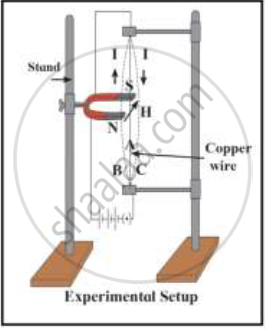Advertisements
Advertisements
प्रश्न
Two coils A and B of insulated wire are kept close to each other. Coil A is connected to a galvanometer while coil B is connected to a battery through a key. What would happen if:
a current is passed through coil B by plugging the key?
Explain your answer mentioning the name of the phenomenon involved.
उत्तर
If current is passed through coil B by plugging key, the galvanometer pointer will move to one side. The movement of galvanometer pointer shows that a current is induced in the coil.
संबंधित प्रश्न
A positively-charged particle (alpha-particle) projected towards west is deflected towards north by a magnetic field. The direction of magnetic field is ______.
State Fleming's left hand rule.
State qualitatively the effect of inserting an iron core into a current-carrying solenoid.
State whether the following statement is true or false:
The magnetic field inside a long circular coil carrying current well be parallel straight lines.
What are the various ways in which the strength of magnetic field produced by a current-carrying circular coil can be increased?
A current-carrying conductor is held in exactly vertical direction. In order to produce a clockwise magnetic field around the conductor, the current should passed in the conductor:
(a) from top towards bottom
(b) from left towards right
(c) from bottom towards top
(d) from right towards left
In the simple electric motor of figure given below, the coil rotates anticlockwise as seen by the eye from the position X when current flows in the coil

Is the current flowing clockwise or anticlockwise around the coil when viewed from above?
i) Which principle is explained in this figure?
ii) Which rule is used to find out the direction of a force in this principle?
iii) In which machine this principle is used? Draw a diagram showing working of that machine

What do you know about Michael Faraday?
Assertion (A): A current carrying straight conductor experiences a force when placed perpendicular to the direction of magnetic field.
Reason (R): The net charge on a current carrying conductor is always zero.
